Home|Glossary|Links|Journal|Maps
Treading
Lightly
It
was after dinner and I went outside to take care of one of our daily
chores – emptying the gray water bucket into a 55-gallon drum.
Gray water is the water that has rinsed tomato sauce and bacon grease
off dirty dishes and pots. Gray water is the water people have used
to wash their hands after going to the bathroom. Gray water is the
water people have sloshed around in their mouths after brushing their
teeth, mixed with saliva, soapy toothpaste and food tidbits, then
spit out. And gray water was the water I had just spilled all over
my Carhart overalls. I was upset. Then I tried to put things in perspective.
I hadn’t showered in two weeks and hadn’t done laundry
in three. Another stain, some more smells – big deal. It was
all part of life in the valleys, part of our efforts to live according
to the Dry Valleys Code of Field Conduct.
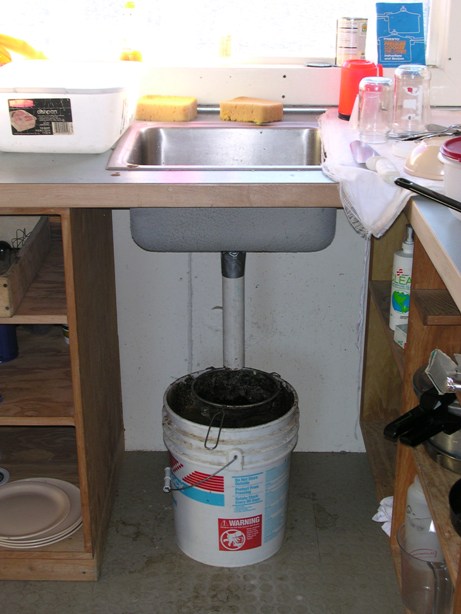 The
gray water system at the F6 camp.
The
gray water system at the F6 camp. |
 “Gray”
water
“Gray”
water |
The
code was one result of a 1995 workshop to discuss environmental
management that would protect the Valleys’ wilderness,
aesthetic, and scientific values for future generations. The
U.S. National Science Foundation sponsored the workshop, which
was held in Santa Fe, New Mexico. Thirty-three people from nine
different countries participated, including Stream Team head
Dr. Diane McKnight. The code was developed as a set of guidelines
for those of us who work in the valleys. It asks us to take
certain actions - actions that will minimize our environmental
impact.
Thus, as much as possible we
use established camps so as not to disturb new areas. For the
same reason we reuse old tent sites; we walk on set trails when
we can; and helicopters take off and land from fixed locations.
At the camps, we make sure to
secure our gear so that it won’t blow away. To the greatest
extent possible, we use renewable sources of energy. Each of
the established camps now has solar panels and one has a wind
generator as well. This minimizes the gas and oil that must
be transported to the valleys and the possibility of spills.
|
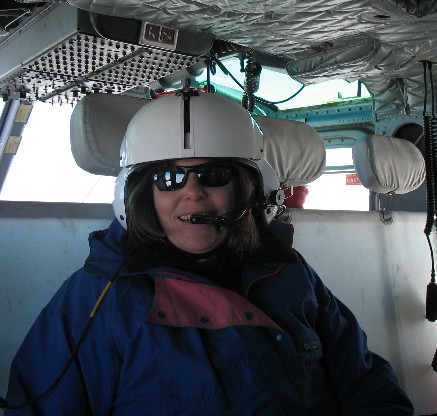 Diane
inside a helicopter
Diane
inside a helicopter
on a flight to Taylor Valley.
|
The 55-gallon drums holding the oil
and gas that we do use are kept inside a containment berm. When we
fuel generators or the vehicles that we drive on lake ice we do so
over drip pans and with absorbent spill pads in hand.
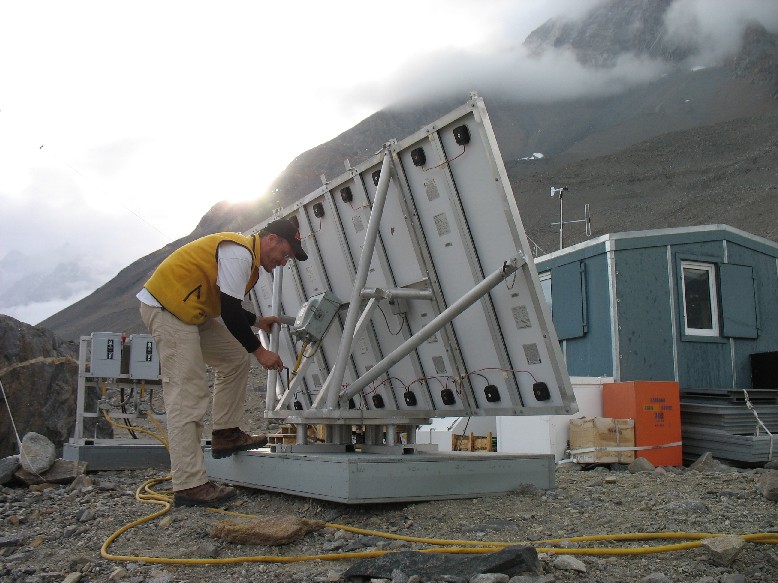 Corey
Peterson turns the solar panels
Corey
Peterson turns the solar panels
at the Lake Hoare camp.
|
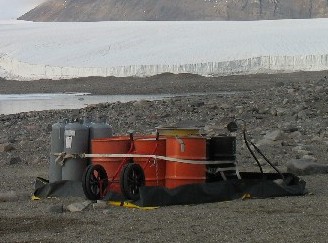 Urine
barrels, gray water barrels, and fuel
Urine
barrels, gray water barrels, and fuel
sit inside a spill containment berm
at the F6 camp. |
In order not to introduce any foreign
bacteria or sources of nutrients, all the water that we use is helicoptered
offsite. So we minimize water use in the field. That means no laundry.
Showers happen at most once a week and with less than three gallons
of water.
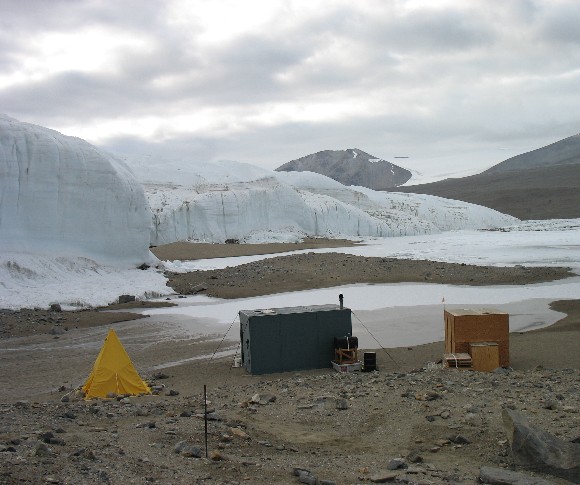
The blue building is the shower hut
at the Lake Hoare camp.
|
 A
view inside the shower hut
A
view inside the shower hut
|
When we make pasta, we save the water
to wash dishes later. Because we have no pipe system for water supply
or disposal, the gray water that results is collected in buckets and
eventually transferred to 55-gallon drums that are located in the
containment berm along with the gas and oil.
BERRY
PICKING
In
addition to environmental management, we have another reason
for minimizing water use. With no running faucets, we have
to get all the water we use ourselves. Later in the field
season we carry water from the lake moats or from a nearby
stream back to camp. But early on, before thawing has progressed,
we must chip lake ice and melt it down. At the lake Hoare
Camp, we also go to the nearby Canada Glacier, gather glacier
berries, and melt those down. These berries lie at the glacier’s
base and are formed when fragments of the glacier break off
or calve and fracture into smaller ice pieces, the berries.
Ice berries are much larger than the fruity kind and to collect
them we chip at them with an ice axe or chipper bar. That’s
what 2003-4 stream teamer Justin Joslin is doing in this photo.
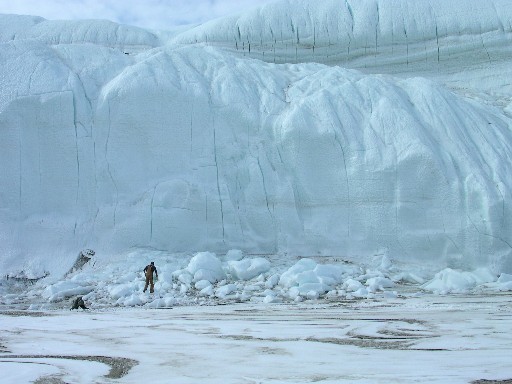
|
ANATOMY
OF A SLINGLOAD
If
we have a lot of equipment, fuel, or waste that needs to be
transported or if our equipment is too big or oddly shaped to
fit inside the helicopter, helo operations will often move it
as a slingload. The first step in putting together a slingload
is opening a mesh net that the load will sit inside. A wooden
pallet is then placed on top of the net and a large reinforced
cardboard box is placed on top of that. We pack our “stuff”
inside the box and then use cargo straps to close it. If our
stuff consists of, for instance, 55-gallon urine or gray water
drums, they can sit on the pallet directly. The mesh is then
wrapped around the boxes or drums to create a kind of sack.
The mesh is attached to a long cable that is hooked underneath
the helicopter. When the helicopter takes off it lifts the cable
and attached load with it and carries it away.
Taylor Valley
camp manager Rae Spain organized the preparation of several
slingloads at the stream team’s main camp F6 towards the
end of our season. Assistant camp manager Heidi Hausman, helicopter
pilot Mark DeWolf, and stream team members Josh Koch and Shannon
Horn helped. See
photos here
Heidi did the
hooking of this particular load. Then she pulled down on the
cable to make sure it was secure and walked away to get out
of the slingload’s path. Pilot Mark DeWolf was flying.
See photos here |
Like the gray water, at many of the
camps, including the main stream team camp at F6, all human waste
is helicoptered offsite. For transport purposes we must keep our poop
and pee separate. First thing in the morning this is a lot harder
than it may sound! At camp we poop in a 5-gallon bucket and pee in
a coffee can. The buckets eventually get capped and shipped off. The
pee is transferred to a urine barrel that is inside the berm as well.
If we are hiking around we pee into a one-liter Nalgene bottle and
somehow get our poop into a bag. We then carry our waste back to camp.
The main Taylor Valley camp at Lake Hoare has “rocket toilets.”
It’s a special treat to use these toilets because we can poop
and pee into the same receptacle. Instead of being helo’ed offsite,
the waste in the toilets gets incinerated.
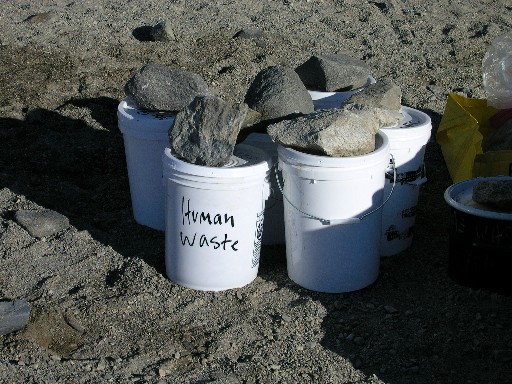 A
season’s worth of poop
A
season’s worth of poop |
|
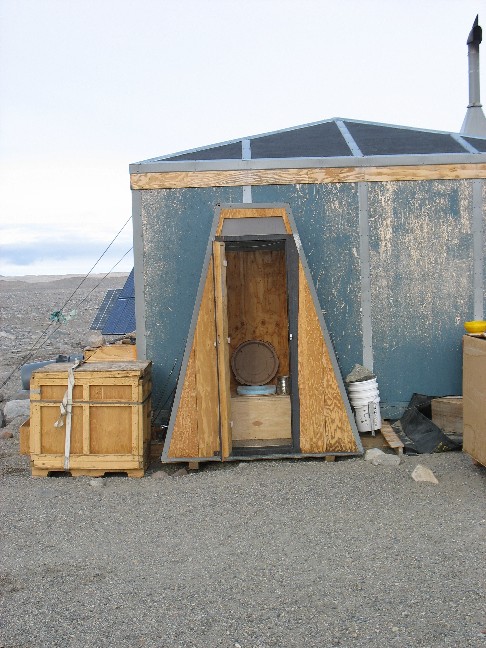 |
| |
The
outhouse at the F6 camp.
|
CAPITAL
P
The
pee bottles that we carry in the field are one-liter
Nalgenes. Our drinking water bottles are one-liter Nalgenes
as well.That
could lead to some tricky situations.
To
avoid any untoward mishaps, most of us have huge P letters
marked on the urine bottles.
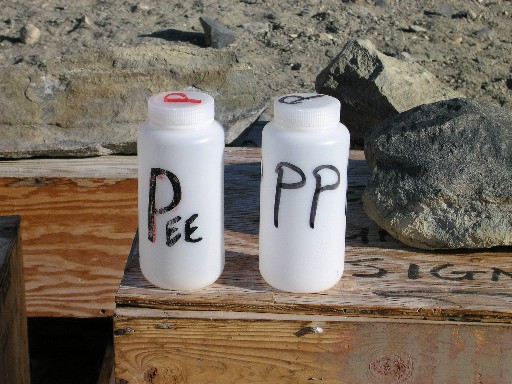
Pee
bottles
|
All this may seem like a hassle.
We certainly grumble on occasion, complain about the oil in our
hair, that we are tired of smelling each other and ourselves,
that we would like nothing better than to have a flush toilet,
and wouldn’t it be nice to turn on a faucet, have hot water
run out, and disappear down a drain. But in the end, these things
seem quite small. We get to live in one of the most beautiful,
unique, and pristine places in the world. It is a place where
biological communities my have taken decades or even thousands
of years to develop, where some geological features data back
millions of years, where the ecosystem has very little natural
ability to recover from human disturbance, and where up until
100 years ago no person had ever set foot. |
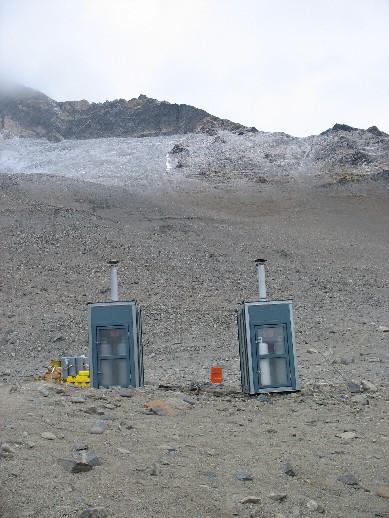
The
rocket toilets at the
Lake Hoare camp
The other waste
we generate at camp gets separated into one of nine categories
for recycling and disposal purposes. These categories include:
glass, light metal, cardboard, plastics, burnables, food waste,
batteries, lab waste, and construction debris.
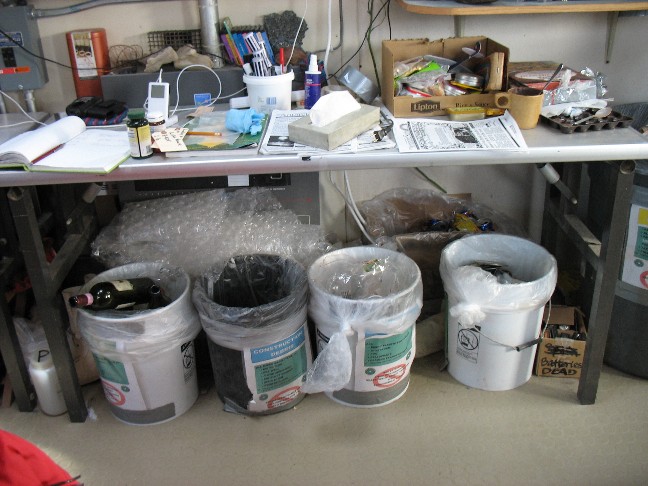
Sorting waste at the Lake
Hoare camp
|
Thinking of pollution prevention and
picking up after ourselves seem the least we can do.
- Karen

Diane and stream team member Josh
Koch sample stream algae.
|










